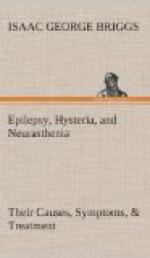Suggestion treatment is of great use in curing nervous states and bad habits, and all neuropaths should practice self- or auto-suggestion. In severe cases a specialist must give the treatment.
The patient is taken by the neurologist to a cosy, restfully-furnished, half-lighted room, and placed in a huge easy chair facing a cheery fire. He sinks into the depths of the chair, relaxes every muscle, allows his thoughts to wander pleasantly, and soon his brain is at rest, and his mind, undisturbed by the fears which usually harass it, is ready to receive suggestions.
The doctor talks quietly, soothingly, but with the conviction born of knowledge to the patient about his trouble, assuring him that he can control his cravings; that he can put away the doubts or fears that have grown upon him. The true reason of his illness is pointed out, any little organic factors given due weight, and the idea that it is hereditary or due to Fate dispelled. Faults of character, reasoning and living are unsparingly exposed and appropriate remedies suggested, and he is shown how unmanly his self-torturing reproaches are, and how futile is remorse unless transmuted into reform.
The doctor’s earnestness inspires confidence, and the patient unburdens his secret troubles, discusses means of remedying them, and turns from pain to promise, from remorse to resolve, from introspection to action, from dreading to doing.
Struck by the way the psycho-analyst reads his soul and lays bare petty meannesses, impressed by the patient thoroughness with which the doctor attends to each little symptom, confident that organic troubles—if there be any—will receive appropriate treatment, ready to carry out instructions, and disposed to believe the new treatment is of real value: under all these circumstances, the physician’s suggestions carry very great weight with the patient.
The resolutions passed by the victim in this calm state sink deep into subconsciousness, and when next temptation, impulse or fear assails him, his own resolutions and the doctor’s suggestions are so vividly recalled that he tries to control his thoughts, and, in due time he “wins out”.
Anyone may induce the calm state, and repeat suitable suggestions. The patient should go to a quiet room, and, reclining on a comfortable couch before a cheery fire, close the eyes, relax the muscles, breathe deeply, and avoid all sense of strain.
The next step is to fix the imagination on some scene which suggests tranquility—smooth seas, autumnal landscapes, snow-clad heights, old-world gardens, deep, shady silent pools, childhood’s lullabies, secluded backwaters, dim aisles of ancient churches.
After a few evenings’ practice, you will be able gradually to exclude all other ideas, and focus on one, inducing a state which, somewhat similar outwardly, is free from the excitement of religious exaltation, and from the delusions of a medium’s trance.




